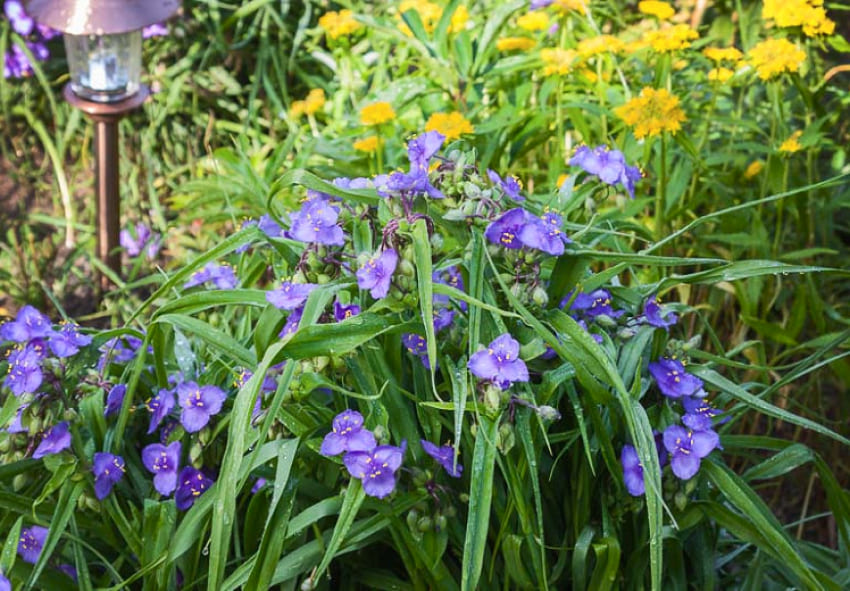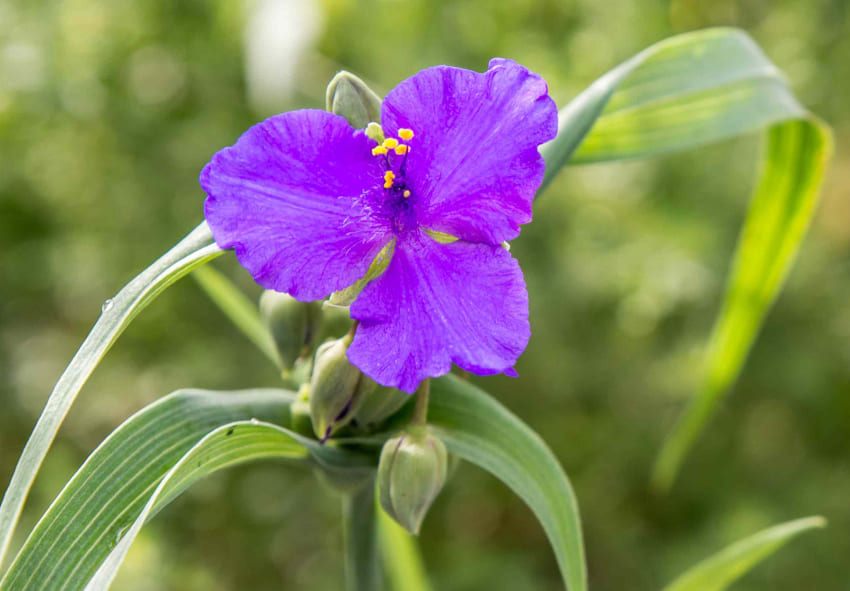Tradescantia, commonly known as Spiderwort, is a beloved plant in the gardening community due to its vibrant colors and easy maintenance. Its popularity spans both indoor and outdoor gardens, making it a versatile choice for plant enthusiasts. Understanding the proper care and planting techniques for Tradescantia is essential to ensure its healthy growth and beautiful display. Our blog is a perfect place to find all the information you need!
Understanding Tradescantia
To grow Tradescantia successfully, it’s essential to understand the different varieties and their unique characteristics. This knowledge will help you choose the right type for your garden or home, whether you prefer indoor or outdoor plants.
Varieties of Tradescantia
Tradescantia comes in various types, each with unique characteristics. Common varieties include:
| Botanical Name | Colour | Flowering Period | Height | Ideal for Containers | Climate |
| Tradescantia pallida | Purple, Pink | Spring to Fall | 6-12 inches | Yes | Tropical, Subtropical |
| Tradescantia zebrina | Purple, Green, Silver | Spring to Fall | 6-12 inches | Yes | Tropical, Subtropical |
| Tradescantia virginiana | Blue, Purple, Pink | Spring to Summer | 12-24 inches | Yes | Temperate |
| Tradescantia fluminensis | Green, White | Year-round | 6-12 inches | Yes | Tropical, Subtropical |
| Tradescantia sillamontana | Purple, Pink | Summer to Fall | 12-18 inches | Yes | Arid, Semi-arid |
Planting Tradescantia
Proper planting is key to the healthy growth of Tradescantia. By selecting the right location, understanding the best planting times, and following a few simple steps, you can ensure your Tradescantia thrives in any setting.
Choosing the Right Location

Selecting the right location for Tradescantia is crucial. These plants prefer bright, indirect sunlight but can tolerate partial shade. Well-draining soil is essential to prevent root rot, and a slightly acidic to neutral pH is ideal. When planting in garden beds, ensure sufficient space for spreading, particularly for trailing varieties.
Best Time to Plant Tradescantia
The best time to plant Tradescantia is during the spring or early summer when temperatures are mild and consistently above freezing. This timing allows the plant to establish its roots and adapt to its new environment before the harsher conditions of winter. In cooler climates, it’s essential to wait until the last frost has passed to ensure that the young plants are not damaged by late frosts.
Tradescantia is hardy in USDA zones 4-10, but specific varieties may have slightly different tolerances. Therefore, understanding your local climate and choosing the appropriate Tradescantia variety for your zone will help you determine the optimal planting time. By planting in the spring or early summer, you give your Tradescantia the best chance to thrive and develop a robust root system.
How to Plant Tradescantia
To plant Tradescantia, follow these tips:
- Prepare the Soil: Amend the soil with compost to improve fertility. Ensure the soil pH is slightly acidic to neutral (6.0 to 7.0).
- Planting from Seeds: Sow Tradescantia seeds indoors 6-8 weeks before the last frost date. Plant seeds 1/4 inch deep in seed-starting mix and keep them moist. Transplant seedlings outdoors after the danger of frost has passed.
- Planting from Cuttings: Take a 4-6 inch cutting from a healthy Tradescantia plant. Remove the lower leaves and dip the cut end in rooting hormone. Plant the cutting in a pot filled with a mixture of perlite and peat moss. Keep the soil moist and place the pot in a warm, bright location until roots develop.
- Transplanting Seedlings or Cuttings: Dig a hole twice the size of the root ball. Place the plant in the hole and backfill with soil, pressing gently to remove air pockets. Water thoroughly to settle the soil around the roots.
- Spacing: Space plants 12-18 inches apart to allow for growth and air circulation.
- Mulching: Apply a layer of mulch around the base of the plant to retain moisture and suppress weeds. Keep mulch away from the stem to prevent rot.
Caring for Tradescantia

Tradescantia requires specific care to maintain its vibrant appearance and health. Understanding its watering, fertilizing, and pruning needs will help you keep your plant lush and beautiful throughout the year.
Watering Needs
Tradescantia prefers consistently moist soil but is susceptible to root rot if overwatered. Water the plant when the top inch of soil feels dry. In hotter climates or during summer, increase watering frequency but reduce it during the winter months.
Fertilizing Tradescantia
To fertilize Tradescantia you need to know some useful advices:
- Choose the Right Fertilizer: Use a balanced, water-soluble fertilizer with equal parts nitrogen, phosphorus, and potassium (e.g., 10-10-10).
- Application Frequency: Fertilize Tradescantia every 4-6 weeks during the growing season (spring and summer).
- Dilute the Fertilizer: Dilute the fertilizer to half the recommended strength to avoid over-fertilizing.
- Apply Evenly: Apply the fertilizer evenly around the base of the plant, avoiding direct contact with the leaves and stems.
- Water After Fertilizing: Water the plant thoroughly after applying fertilizer to help distribute nutrients and prevent root burn.
Pruning and Maintenance
Regular pruning helps maintain the shape and health of Tradescantia. Trim back leggy stems to encourage bushier growth. Deadheading spent flowers and removing dead or yellowing leaves keeps the plant looking neat and vibrant.
Mulching and Weed Control
Applying a layer of mulch around Tradescantia helps retain soil moisture and suppress weeds. Use organic mulch like bark or straw, ensuring it does not touch the plant’s stems to prevent rot. Regularly check for weeds and remove them promptly to reduce competition for nutrients and water.
Pest and Disease Management

Managing pests and diseases is crucial for the well-being of your Tradescantia. Identifying common issues and knowing how to prevent and treat them will protect your plant from damage and keep it thriving.
Common Pests
Tradescantia can be affected by pests like:
Aphids
- Description: Small, soft-bodied insects that can be green, black, brown, or pink.
- Damage: They suck sap from plants, causing leaves to yellow and curl.
Spider Mites
- Description: Tiny, spider-like pests that are often red or yellow.
- Damage: They feed on plant sap, leading to stippled, yellowing leaves and fine webbing on the plant.
Mealybugs
- Description: Small, white, cottony insects that cluster on plant stems and leaves.
- Damage: They suck plant juices, causing stunted growth and yellowing leaves.
Scale Insects
- Description: Small, round or oval insects that adhere to plant stems and leaves, appearing as small bumps.
- Damage: They feed on plant sap, leading to weakened plants and sooty mold development.
Whiteflies
- Description: Tiny, white, winged insects that fly up in clouds when disturbed.
- Damage: They suck plant juices, causing yellowing and wilting of leaves.
Disease Prevention

Common diseases in Tradescantia include fungal infections and root rot. To prevent these, avoid overhead watering and ensure proper air circulation around the plants. Tradescantia plants thrive in well-draining soil, which helps prevent water from pooling around the roots, reducing the risk of root rot. When watering, focus on the base of the plant rather than the foliage to minimize the risk of fungal infections.
If you notice signs of disease, such as wilting, yellowing, or discolored leaves, it’s crucial to act quickly. Remove any affected parts of the plant to prevent the spread of the disease. Treat the remaining healthy parts with appropriate fungicides as recommended for Tradescantia. Additionally, maintaining a clean growing environment by regularly removing debris and dead leaves can help prevent disease outbreaks.
Propagating Tradescantia
Propagating Tradescantia is an excellent way to expand your collection or share with friends. Whether you choose to propagate by cuttings or division, understanding the best practices will ensure successful growth of new plants.
- Propagation by Cuttings
Propagating Tradescantia from cuttings is a simple and effective method. Cut a healthy stem just below a node, remove the lower leaves, and place the cutting in water or directly in soil. Ensure it receives bright, indirect light and keep the soil or water consistently moist until roots develop.
- Propagation by Division
To propagate by division, carefully dig up a mature Tradescantia plant and divide the root ball into sections, ensuring each section has roots and shoots. Replant the divisions in prepared soil, water thoroughly, and provide them with the same care as mature plants.
Using Tradescantia in Garden Design

Tradescantia’s versatility makes it a fantastic choice for garden design. Whether you’re landscaping your garden beds or creating stunning container arrangements, incorporating Tradescantia can add color, texture, and interest to your space.
Landscaping with Tradescantia
Tradescantia can add vibrant color and texture to any garden by been used in different designs like:
- Garden Borders: Use Tradescantia to create colorful, low-maintenance borders along pathways and garden edges.
- Ground Cover: Plant Tradescantia as a ground cover to fill in gaps and suppress weeds, especially in shaded areas.
- Mixed Flower Beds: Combine Tradescantia with other flowering plants for a vibrant and diverse garden bed.
- Hanging Baskets: Utilize trailing varieties of Tradescantia in hanging baskets for cascading foliage and blooms.
- Rock Gardens: Incorporate Tradescantia in rock gardens for a pop of color and texture among stones and other succulents.
- Water Features: Add Tradescantia around water features such as ponds or fountains for a lush, tropical feel.
- Shade Gardens: Use Tradescantia in shady spots where other plants may struggle to thrive, providing color and interest.
Tradescantia in Containers
Tradescantia thrives in containers, making it a versatile option for indoor and outdoor gardening. Create attractive arrangements by combining Tradescantia with other plants in pots or hanging baskets. Ensure good drainage and regular watering, and rotate the containers to promote even growth.
Conclusion
Growing Tradescantia is a rewarding experience that offers vibrant colors and unique textures to your garden or home. By understanding proper care, planting techniques, and propagation methods, you can enjoy the beauty and benefits of Tradescantia year-round. Experiment with different varieties and designs to find the perfect fit for your gardening style.
Frequently Asked Questions (FAQs) about Tradescantia
1. What are the best lighting conditions for Tradescantia?
Tradescantia thrives in bright, indirect light. While it can tolerate lower light levels, the plant will grow more vigorously and exhibit more vibrant colors in bright, filtered sunlight. Avoid placing Tradescantia in direct sunlight for prolonged periods, as this can cause leaf burn.
2. Can I purchase Dutch Tradescantia bulbs from your online store?
Yes, you can find a variety of Tradescantia bulbs available for purchase in our online store Dutch-bulbs.com. We offer a range of colors and varieties to suit your preferences. Our bulbs are carefully selected for quality, and we provide detailed planting and care instructions to help you successfully grow your Tradescantia flowers.
3. How often should I water Tradescantia?
Tradescantia prefers to be kept consistently moist but not waterlogged. Water the plant when the top inch of soil feels dry to the touch. Ensure that the pot has proper drainage to prevent root rot. During the winter months, reduce watering frequency as the plant’s growth slows down.
4. Can I grow Tradescantia outdoors?
Yes, Tradescantia can be grown outdoors in USDA zones 4-10. It’s ideal for shaded or partially shaded garden areas. In cooler climates, you may need to bring Tradescantia indoors during the winter or provide protection against frost.
5. What are common pests and diseases affecting Tradescantia, and how can I manage them?
Common pests affecting Tradescantia include aphids, spider mites, and mealybugs. To manage these pests, use insecticidal soap or neem oil. For diseases like fungal infections and root rot, ensure proper air circulation, avoid overhead watering, and treat affected plants with appropriate fungicides. Regularly inspect your plants to catch and address issues early.
Published: 09.08.2024

